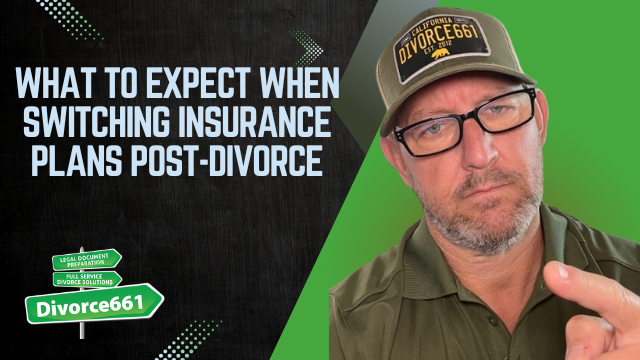What to Expect When Switching Insurance Plans Post-Divorce
I’m Tim Blankenship from Divorce661. If you’ve recently finalized a divorce, one of the most important—but often overlooked—tasks is updating your insurance. A few simple changes can prevent major headaches, out-of-pocket costs, and coverage gaps. Below I walk through what to expect when switching plans after divorce and provide a clear checklist to get this handled fast.
Why updating insurance matters
After a divorce your legal and financial responsibilities change. If your auto, homeowners, health, or life insurance still lists your ex or the old marital household, an accident or claim can become a complicated mess. I’ve seen minor incidents turn into big problems simply because policies weren’t updated. Protect yourself now so you don’t learn the hard way later.
Health insurance: COBRA, employer plans, and Covered California
When you lose access to your spouse’s employer-sponsored health plan, you generally have a few options:
- COBRA — Temporary continuation of the employer plan. It keeps the same coverage, but you pay the full premium (employee + employer share), which can be expensive.
- Employer plan — If you are employed, compare your employer’s plan versus COBRA. Employer plans are often cheaper and worth enrolling in during open enrollment or qualifying life events.
- Covered California / Marketplace — You may qualify for subsidized coverage depending on your income. This can be significantly less expensive than COBRA.
- Medi-Cal — Low-income Californians may qualify for Medi-Cal, which is usually free or very low cost.
Action steps:
- Check COBRA eligibility and cost immediately after finalizing divorce.
- Review your employer’s options and enroll if eligible.
- Shop Covered California to see if you qualify for subsidies.
- Compare premiums, deductibles, networks, and out-of-pocket maximums before deciding.
Auto insurance: who should be on the policy?
Your living situation dictates what to do with auto insurance:
- If you move out: Get your own auto policy in your name right away. Insurers expect the vehicle (and primary driver) to be accurately listed. If your car remains on your ex’s policy, you could lose coverage or face disputes after an accident.
- If you stay in the marital home: Make sure the policy is transferred to your name if the court awards the vehicle to you or if you become the primary driver. If ownership changes, update the policy and title as required.
- Update addresses and drivers: Insurers use address and household information to assess risk. Keep this current to avoid claim denials or premium adjustments.
Homeowners insurance: transferring or getting new coverage
Homeowner policy changes depend on ownership and occupancy:
- If you move out: Notify your insurer and obtain your own renter’s or homeowners policy if you have property to insure.
- If you remain in the marital home: Transfer the homeowner’s policy to your name if your court agreement or deed reflects that change. If a policy remains on your ex’s name but you’re living there, clarify coverage responsibilities to avoid denial of claims.
- Mortgage requirements: Lenders often require the borrower to maintain homeowner’s insurance — make sure the policy matches the name on the mortgage and the deed.
Life insurance: update beneficiaries and align with support obligations
Life insurance is commonly used to secure child support, alimony, or other financial obligations. After divorce:
- Review beneficiaries immediately. Your divorce judgment may require a policy to name a former spouse, children, or a trust — follow those instructions exactly.
- Contact your insurer to change beneficiaries if the judgment allows or requires it.
- If your judgment requires maintaining a policy (e.g., for child support), verify that coverage amounts and beneficiary designations remain in force until obligations end.
Real client example — a small accident, big problem
One client moved out and assumed her auto and homeowners info would be fine. A minor fender bender revealed that her information was still tied to the old policy. That led to a fight over who was responsible, complications with claims, and unnecessary stress. That scenario is avoidable by updating policies and confirming coverage in writing.
Practical checklist: update these items right away
- Notify and update your health insurance options — COBRA, employer, Covered California, or Medi-Cal.
- Get auto insurance in your name if you moved or if ownership/primary driver changed.
- Transfer or obtain homeowner’s/renter’s insurance consistent with ownership and mortgage terms.
- Update life insurance beneficiaries and ensure any required policies for support are maintained.
- Provide insurers with court documents if needed to verify changes.
- Keep copies of updated declarations pages and confirmations in a safe place.
Tips to make the process smoother
- Start immediately — many coverage options are time-sensitive.
- Ask insurers what documentation they need (divorce decree, proof of address, vehicle title).
- Compare costs and networks before choosing between COBRA, employer coverage, or marketplace plans.
- Keep records of all communications and policy changes.
Conclusion — protect yourself going forward
A simple update can make a world of difference. Taking care of insurance changes post-divorce avoids unnecessary stress, financial risk, and potential legal complications. If you need help reviewing and updating your policies, Divorce661 offers flat-fee, 100% remote support and a free consultation to get you protected.
Take action today: visit Divorce661.com for a free consultation and let us help you navigate these changes confidently.





